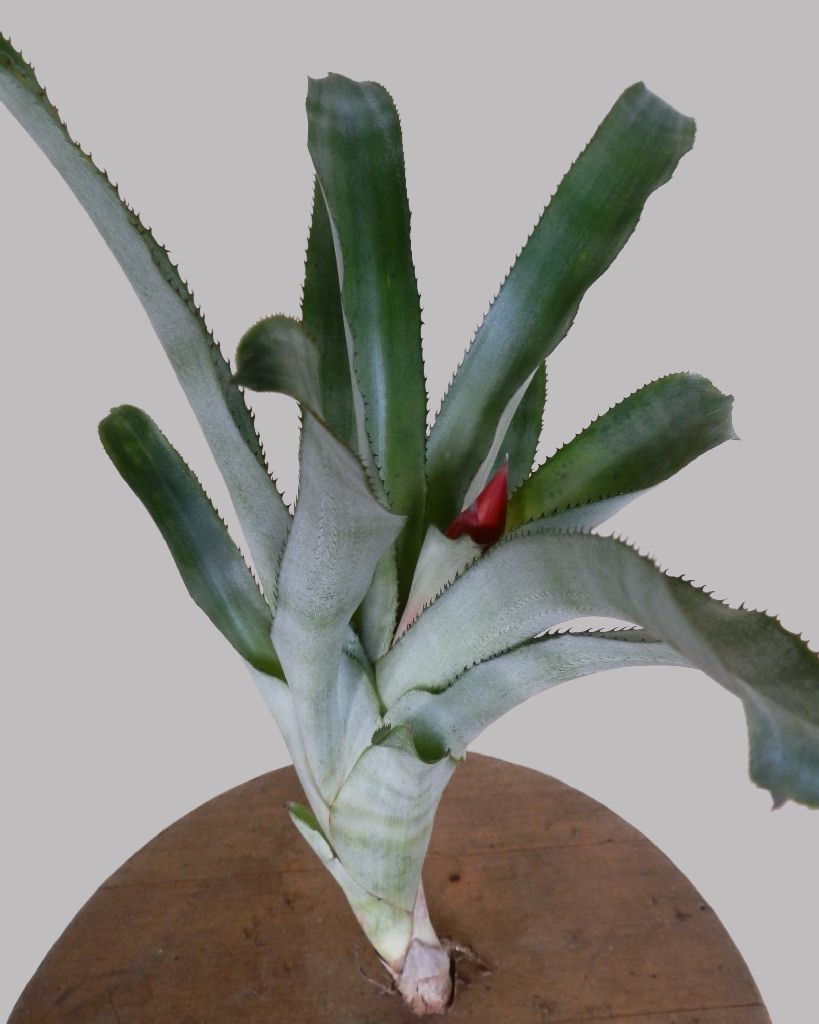
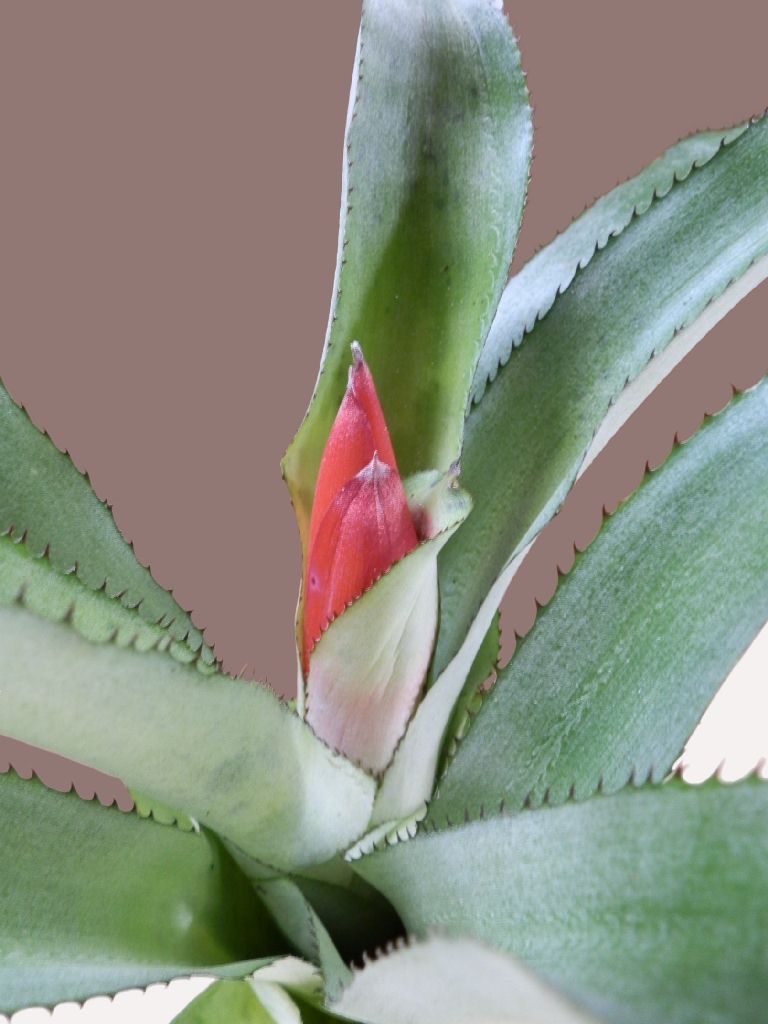
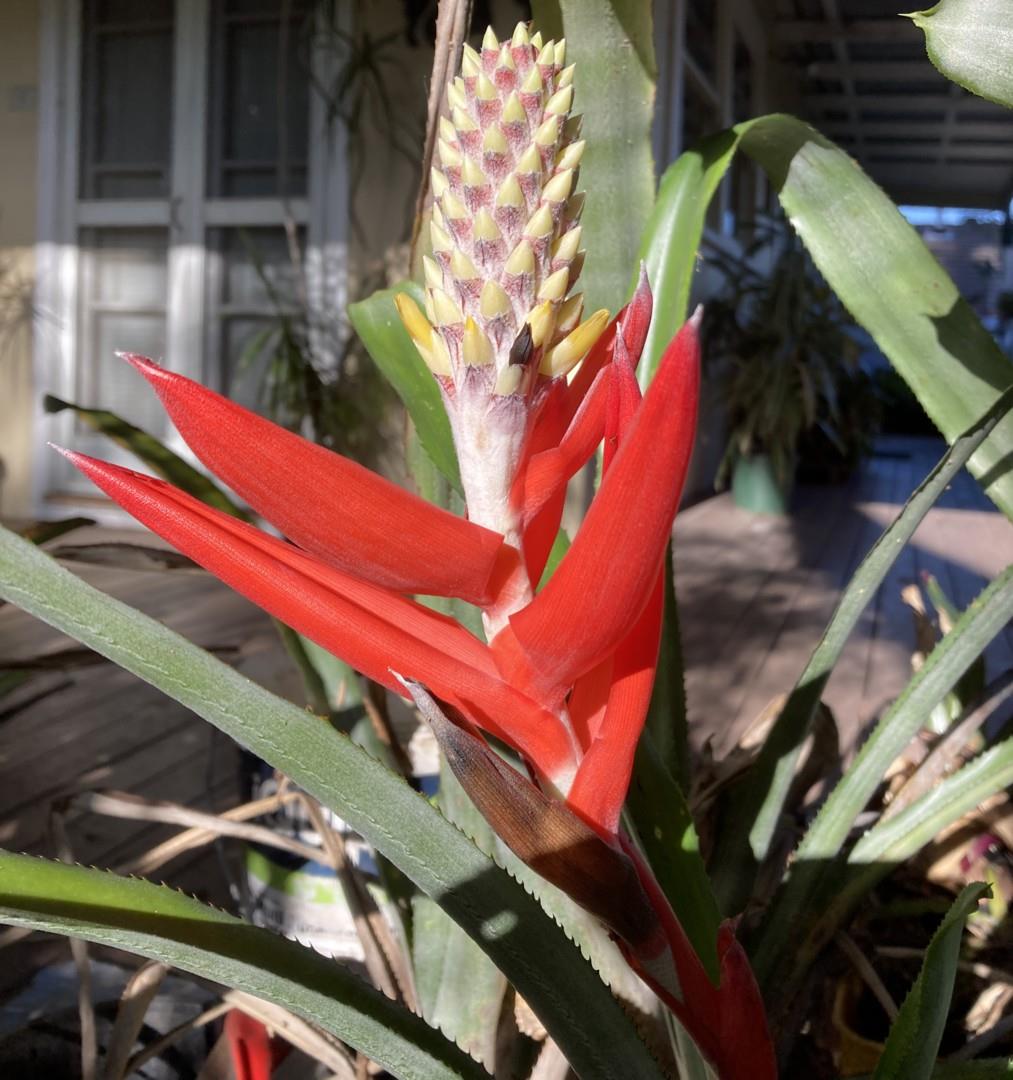
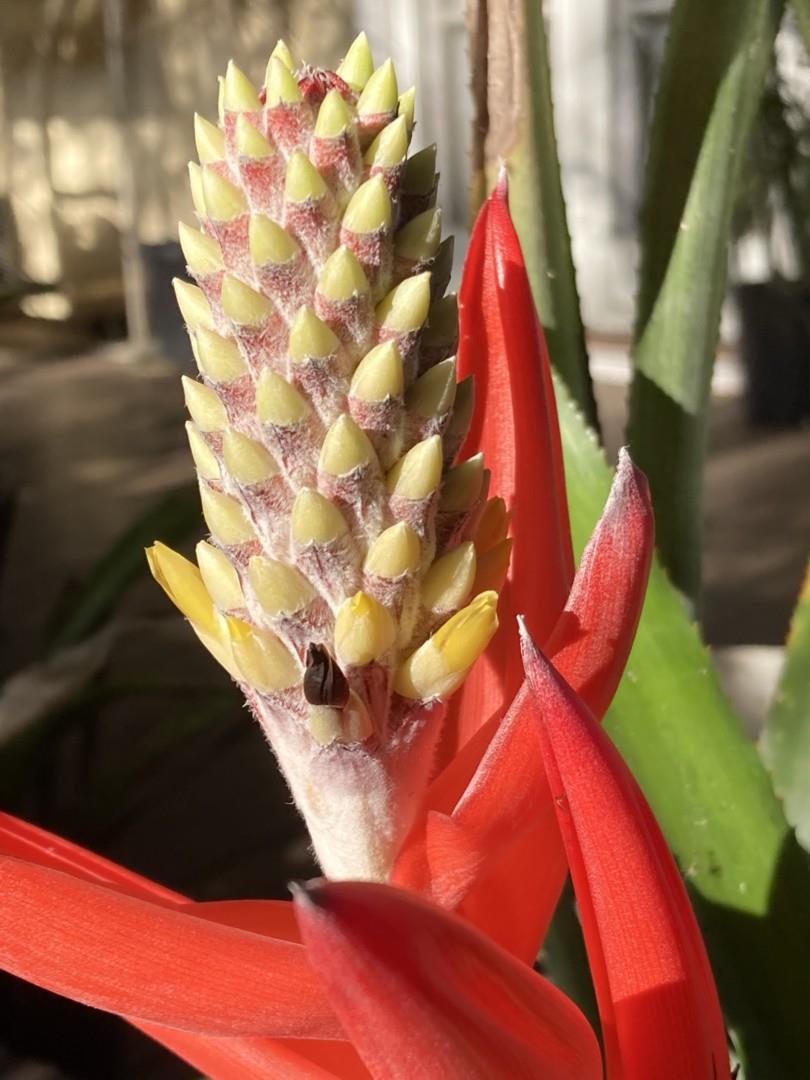
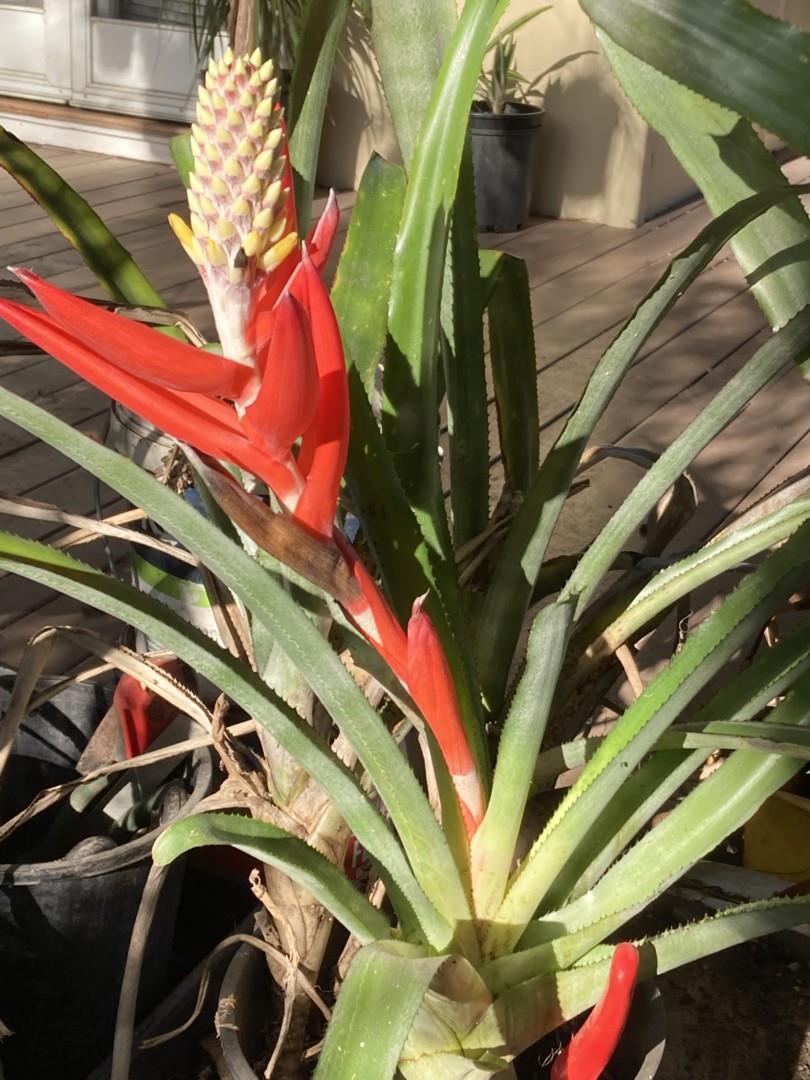
Desc from S&D
Leaves 5 dm long, green, wholly covered with coarse pale appressed scales;
Sheaths broadly elliptic, 12 cm long;
Blades ligulate, acute, 3 cm wide, laxly serrate with spreading teeth 3 mm long.
Scape 4 dm long, 4 mm in diameter, densely white-flocculose;
Scape-bracts thin, roseate, white-lepidote, the lower ones elliptic, about equaling the internodes, serrate near their apices, the upper ones lanceolate, much exceeding the internodes, massed below the inflorescence, entire.
Inflorescence simple, densely strobilate, ellipsoid, 7-9 cm long, 35-40 mm in diameter, covered with white appressed scales.
Floral bracts suberect, broadly cymbiform, broadly acute or obtuse and apiculate, thick-coriaceous and bicarinate or tricarinate but near the apex rather thin and distinctly nerved, about equaling the ovary.
Sepals strongly asymmetric, 12 mm long, connate for 2 mm, unarmed;
Petals erect, 20 mm long, bearing 2 lacerate scales at base, fleshy, quickly turning black;
Epigynous tube broad, conspicuous;
placentae apical;
ovules long-caudate.
Type. Foster 830 (holotype, GH), Santa Teresa, Espirito Santo, Brazil, 6 Aug 1940, bloomed in cultivation Jun 1942.
Distribution. Epiphytic, Bahia and Espirito Santo, Brazil.
BRAZIL. Bahia: Santa Cruz de Cabr1llia to Porto Seguro, 19 Mar 1968, Vinha & Santos 64 (UB, US); Parque Nacional de Monte Pascoal, 21 Mar 1968, Vinha & Santos 90 (UB, US). Espirito Santo: Santa Teresa, 1939, Foster 176-8 (GH).
Most bromeliad growers, especially those living in warm climate areas where they can keep some of their collections outdoors, cultivate members of Aechmea subgenus Macrochordion (the "bromeliifolia group"). From my experience, many of these plants are misnamed in horticulture. With the exception of some very distinctive species such as A. triangularis (Syn.: A. kautskyana), most of these similar-appearing plants are identified as A. bromeliifolia. The latter species may be treated in a future instalment of this series; for now, I will discuss and illustrate three which I have found to be misidentified in horticulture and in herbaria.
Aechmea lamarchei Mez was described from a cultivated plant late last century. Recently verified specimens have been collected in the Brazilian State of Minas Gerais. The cultivated plants, probably introduced by M. B. Foster, most likely originated from there as well. Aechmea lamarchei is very distinctive as it has the longest flowers (more or less 30 mm long) of the group and large, conspicuous, rather papery floral bracts that exceed and conceal the 1/2 connate sepals. Plants commonly found in cultivation have long, coppery-green leaves and are usually quite caulescent.
Aechmea chlorophylla L.B.Smith was collected by the Fosters in 1939 and 1940 from Espirito Santo and Minas Gerais States, and described in 1955. The cultivated stock of this species is likely from these collections. Compared to A. lamarchei the flowers of A. chlorophylla are shorter (more or less 25 mm long) and the thick floral bracts only about equal the ovary. The short-connate sepals are conspicuously exserted beyond the floral bracts. This species is nearly stemless or very short-caulescent. The leaves are green or grey-green. (Note by Butcher and confirmed by HEL. photos of A. chlorophylla in both Baensch and Venezuela book are in fact A. lamarchei !)
A very similar plant is A. pabstii E.Pereiro & Moutinho from Bahia, Brazil. This species differs from A. chlorophylla by having higher-connate sepals and white or pale creamy-yellow petals. Aechmea pabstii is rare in cultivation.
18/04/2010 Derek Butcher to Harry Luther
I enclose what I have on A. lamarchei and A. alba. De Faria, Wendt & Brown convinced me on the A. alba synonyms but not the positioning of A. maculata. Seems you have doubts too. Any further comments you may wish to make, will help a quasi-taxonomist!
19/04/2010 Harry Luther to Derek Butcher
Dear Derek; I don't understand what this is about. A. lamarchei is very distinct, as is maculata. A. chlorophylla is probably the same as A. alba and perhaps pabstii. A. bromeliifolia is also distinct but often confused with all the above.
Note that A. lamarchei has big papery floral bracts like Quesnelia (strict sense). Aechmea bromeliifolia and maculata usually confused especially non-maculate maculata! Note small corolla of A. bromeliifolia.
Aechmea lamarchei Mez, in Martius, Eichler & Urbain, Fl. Bras. 3(3): 370. 1892. by De Faria, Wendt & Brown in Bot Journ. Linn. Soc. 162: 10-18. 2010
Type: Brazil, without specific locality, Lamarche Hortus in Morren Hortus s.n., x.1877 (Holotype: LG! photo).
= Macrochordion lamarchei (Mez) L.B.Sm. & WJ.Kress, Phytologia 66(1): 77. 1989. H. E. Luther & E.Sieff, Selbyana 15 (1):65. 1994, pro syn.
= Aechmea maculata L.B.Sm., Smithsonian Misc. Collect. 126:15, 227, f. 107. 1955. Type: Brazil, Minas Gerais, Belo Horizonte, Pico da Piedade, l0.vii.1940, Foster 561 (Holotype: GH!, Isotype: US! photo, BHCB!), syn. nov.
= Macrochordion maculata (L.B.Sm.) L.B.Sm. & WJ.Kress, Phytologia 66(1): 77. 1989, syn. nov.
= Aechmea chlorophylla L.B.Sm., Smithsonian Misc. Collect. 126:14, 227, f. 108. 1955. Type: Brazil, Espirito Santo, Sta Teresa, 6.viii.1940, Foster 830 (Holotype: GH!, Isotype: US! photo), syn. nov.
= Macrochordion chlorophylla (L.B.Sm.) L.B.Sm. & WJ.Kress, Phytologia 66(1): 77. 1989, syn. nov.
HERB epiphytic, rupicolous or terrestrial, 30-80.5 cm high.
ROSETTE funnelform or wide-funnelform, with 15-30 leaves.
LEAF SHEATHS 10-20 x 2.5-10.5 cm, elliptic to narrow-elliptic, adaxial surface vinaceous, abaxial surface green or sometimes reddish;
LEAF BLADES 17-112.5 x 2-5.5 cm, linear, concolorous green or sometimes concolorous reddish, apex acute or obtuse, apiculate, margins serrate or densely serrate; spines castaneous, 1-3 mm long.
INFLORESCENCE with spike 3.5-12.5 x 1.5-4 cm; peduncle green or reddish, 27-73.5 cm long, white floccose;
peduncle bracts imbricate or subdense, divergent toward the apex of the peduncle, entire or denticulate toward the apex, dark pink or red, 6.5-14 x 2-4 cm, apex acute or acuminate.
FLOWERS 2.2-2.8 cm long.
FLORAL BRACTS 1-2.3 x 1.5-2 cm, ovate or widely ovate, shorter to about equaling the sepals, coriaceous with thin apex, reddish or castaneous, white floccose or appressed lepidote, apex obtuse or emarginate, apiculate.
SEPALS 8-14 x 4-8 mm, distinctly asymmetric, connate near the base or sometimes to the middle, yellow, yellow-greenish or reddish, covered with white appressed scales, apex obtuse, muticous or minutely apiculate.
PETALS 17-23 x 5-6 mm, lingulate, yellow, apex obtuse, erect or slightly divergent; fimbriate ligulae about halfway along the lateral folds.
STAMENS with filaments 9-16 mm long; anthers 5-9 mm long.
STIGMA c. 2 mm long.
OVARY c. 5 mm long, bearing a distinct epigynous tube;
ovules c. 0.5 mm long.
FRUITS greenish; seeds c. 4 mm long, pale brown.
Distribution and habitat: Aechmea lamarchei is distributed in Minas Gerais and inland areas of Espirito Santo state (Fig. 4B). It grows at 500-1700 m altitude, in dense ombrophile forest, semi-deciduous forest and campos rupestres.
Conservation status: Least Concern (IUCN, 2001).
Notes: In the original descriptions of A. chlorophylla and A. maculata, Smith (1955) proposed an affinity of both species with A. bromeliifolia. Multivariate analyses, however, showed that A. bromeliifolia is distinguishable and that there is a close relationship between A. chlorophylla, A. maculata and A. lamarchei. The difficulties to distinguishing these three taxa morphologically were already noted in the work of Smith & Downs (1979). Most of the diagnostic characters presented for A. lamarchei in the key to species of subgenus Macrochordion can also be observed in A. chlorophylla and/or in A. maculata (e.g. leaf blade shape, inflorescence indument type, floral bract apex, leugth of fusion among sepals). We also ascertained that the measures (length and wide) of leaves, leaf blade spines, inflorescences, sepals and petals of A. chlorophylla herbarium specimens examined fit into those described for A. lamarchei. Leaves and peduncle bracts spotted with red, a diagnostic character cited for A. maculata in the Smith & Downs (1979) key, is not clearly defined in the morphological description of this species, which mentions dense and coarse purple spots only on the internal face of the sheaths. Purple sheaths, however, are commonly observed in the subgenus. Other characters employed by Smith & Downs (1979) to distinguish A. lamarchei from A. chlorophylla and A. maculata have been shown to be variable and of dubious interpretation. The white lanate inflorescence cited for A. lamarchei was not observed in herbarium material examined in this study. Instead, we observed floccose to appressed lepidote inflorescences and these characters are cited in the key to identify A. maculata and A. chlorophylla, respectively. Leaf blades linear vs. ligulate, used in the key to differentiate A. lamarchei from A. chlorophylla and A. maculata is not adequate (the three species show linear blades). The distinction between lacerate (cited for A. chlorophylla) and fimbriate petal appendages (cited for A. lamarchei and A. maculata) were not detected in our study and all scales were classified as fimbriate. The connation of the appendages to the petals (slightly above the base cited for A. lamarchei, at the base for A. chlorophylla and above the base, near the middle of the claw for A. maculata) also leads to misinterpretation. We observed that, in all these species, the fimbriate scales are inserted well above the base of the petals and approximately halfway along the lateral folds. Another character employed by Smith & Downs (1979) to distinguish these taxa was the length of fusion among the sepals (half connate for A. lamarchei, approximately half connate for A. maculata and connate at base for A. chlorophylla). Examination of herbarium material, however, showed considerable variation of this character within A. lamarchei. Considering that these species have been hard to distinguish from each other historically, and the close relationships suggested among them by the multivariate analysis, we propose A. chlorophylla and A. maculata as synonyms of A. lamarchei. We consider the coriaceous, ovate to widely ovate floral bracts with obtuse or emarginate thin apices and the large flowers > 2 cm (Fig. 7C, D) relevant to identify A. lamarchei (these characters are also present in A. chlorophylla and A. maculata) and to distinguish this species from other taxa of the subgenus.
Aechmea lamarchei Mez, Mart. Fl. Bras. 3(3): 370. 1892.
Macrochordium lamarchei E. Morren ex Baker, Handb. Bromel. 67. 1889, as "Iamarckii," nomen illegitimum because proposed as a form of Aechmea bromeliifolia (Rudge) Baker. Based on Morren Icon (K).
Aechmea lagenaria Mez, Mart. Fl. Bras. 3(3): 372. 1892. Type. Morren Hortus s n (LG n v); Berlin Hortus (B, clonotype ? , photo F 11318).now treated as a syn. of A. bromeliifolia
Macrochordium lagenarium E. Morren ex Mez, Mart. Fl. Bras. 3(3): 372. 1892; nomen. now treated as as syn. of A. bromeliifolia
Desc. from S&D
Plant flowering 4-15 dm high.
Leaves many in a dense short-cylindric rosette, 4-9 dm long;
Sheaths elliptic, serrate toward apex, covered with white appressed scales on both sides;
Blades ligulate, subrounded and apiculate, 2-4 cm wide, sublaxly serrate with brown spines 1.5 mm long, subglabrous above, covered beneath with white appressed scales, wholly green.
Scape erect, stout, white-flocculose;
Scape-bracts imbricate, large, lance-ovate, acute, papyraceous, bright red, the lower erect and minutely serrulate toward apex, the upper massed below the inflorescence, sub erect and entire.
Inflorescence simple, very densely sub cylindric, obtuse, 5-8 cm long, slightly more than 3 cm in diameter, many-flowered.
Floral bracts broadly ovate, broadly acute to emarginate, never bicarinate, usually slightly exceeding the sepals, entire, membranaceous, white-flocculose toward base;
Flowers sessile, polystichous.
Sepals slightly asymmetric, obtuse, unarmed, 10-11 mm long, half-connate, covered with a pale membrane of fused scales;
Petals to 22 mm long, bearing 2 fimbriate scales slightly above the base, yellow at anthesis but soon becoming black;
Stamens much shorter than the petals;
Ovary to 7 mm long, epigynous tube evident; placentae apical; ovules long-caudate.
Type. Lamarche Hortus in Morren Hortus s n (holotype, LG; photo GH), Oct 1877.
Distribution. Terrestrial in forest, 930-1400 m alt, Bahia to Minas Gerais and Rio de Janeiro, Brazil.
BRAZIL. Bahia: Blanchet 1526 (G; photo F 8486); Colonia Itatinga, Bom Gosto, 21 Dec 1943, Froes 19975 (IAN); Porto Seguro, 19 Jun 1962, Duarte 6782 (RB, abortive axillary inflorescences). Espirito Santo: Domingos Martins, 19 Jul 1939, Foster 176 (GH, R); Cachoeira de Itapemirim, 2 Sep 1948, Brade 19414 (RB, US). Minas Gerais: Saint-Hilaire C-174 (P); Caraca, 1885, Vainio 33943 (TUR); Jun 1885, Gounelle s n (P); Carangola, 4 Feb 1930, Mexia 4316a (GH, US); Vicosa, 24 Jun 1930, Mexia 4789a (GH); 14 Jul 1930, 4859a (GH); Ilheu, Mexia 4972 (GH, US); Conceicao, Jun 1940, Foster 630 (GH, US); Serra do Cipo, 1940, Foster 637 (GH, US); Coronel Fabriciano, 15 Oct 1950, M. Magalhaes 5838 (BHMG, US); Serro to Diamantina, 27 Feb 1968, Irwin, Maxwe// & Wasshausen 20994 (NY). Rio de Janeiro: Macae to Barra de Sao Joao, I. Eraga s n (GUA, R).
From Mez 1935
122. Ae. Lamarchei (Morr.) Mez in Mart. Fl. Brasil. III. 3. (1892) 370.
Macrochordium Lamarchei (sphalm. Lamarckii) Morr. ex Bak. Bromel. (1889) 67, nomen.
Aechmea bromeliifolia Bak., l. c. (e, p.).
Folia multa, linearia, apice breviter et nonnunquam subrotundate acuta et in acuminulum angustum, herbaceum producta, margine spinulis usque ad 1.5 mm longis, aciculosis dense armata, ad 0.4 m longa et 19 mm lata, haud vittata. Vaginae scapales integerrimae. Inflorescentia submulti- vel multiflora, simplicissima, perdense cylindrice spicata, ad 70 mm longa et 35 mm diam. metiens, apice rotundata; bracteis membranaceis, latissime ovatis, breviter acutis, nullo modo duplicimarginatis, 15 mm longis et aequilatis, dorso prope basin tomentellis cet. glabrescentibus, nullo modo incrassatis. Flores sessiles, 22 mm longi; sepalis medium usque connatis, obtusis nec mucronatis, 10 mm longis, paullo asymmetricis. Petala citrina deflorata fere atra, ad 16 mm longa, 3 mm supra basin ligulata. Filamenta ser. II. cum petalis peralte connata; antheris ad 5 mm longis. Ovarium dense lepidotum, 3-4 mm longum; placentis loculis apice affixis; ovulis caudatis.
Brasilien: Staat Minas Geraes, ohne Standortsangabe (St.-Hilaire n. 1741. -Bisweilen in Kultur).
Translated by Butcher
Leaves many, linear, tip short and sometimes sub-rounded acute and narrow acuminate, yellow green extended, margins with spines up to 1.5 mm long, acicular densely armed, to 0.4 m long and 19 mm wide, not at all banded.
Scape bracts entire.
Inflorescence almost many to many flowered, simple, very dense cylindric spike, to 70 mm long and 35 mm diam., tip rounded;
floral bracts membranaceous, very wide ovate, short acute, in no way double edged, 15 mm long and wide, on the back towards the base tomentose the others glabrescent, in no way thickened.
Flowers sessile, 22 mm long;
sepal connate up to the middle, obtuse not mucronate, 10 mm long, a little asymmetric.
Petals yellow after flowering becoming black, to 16 mm long, 3 mm above the base ligulate.
Filaments series II. connate very high with the petals; anther to 5 mm long.
Ovary densely lepidote, 3-4 mm long; placenta joined to the top of the locule; ovules caudate.
Brazil: State of Minas Geraes, without exact location (St.Hilaire n. 1741.)
Sometimes found in cultivation.
19/01/2012 Derek Butcher to Eric Gouda
Eric: Don't give up that easy. The photo from F shows a prominant floral bract which you do not find in A. bromeliifolia. Therefore the two Brazilians and one American are wrong in treating lagenaria/lamarchei as a synonym of A. bromeliifolia. Would it be too cheeky to ask the Field Museum why they filed the photo of the herb specimen under A. lagenaria when the name does not appear on the voucher?
19/01/2012 Eric Gouda to Derek Butcher
Derek: I don't give up, I will get all specimens with the name Ae. bromelifolia scanned from the Morren Herbarium (LG) and hope it will be amongst them.
There are no Aechmea lagenaria/lamarchei specimen as I was told. F has the information from Smith & Downs I suppose, because Smith used the F photos extensively.
The specimen/clonotype is probably lost, if it was the type at all.
12/01/2012 Eric Gouda to Robert Vogt
Dear Robert: I would like to have an high resolution image of the clonotype of Aechmea lagenaria Mez Mart. Fl. Bras. iii. III. 372 (1892).
Could you have a look for this specimen: Brazil. 11/12/1912. Strauss, H. s.n. (B (photo F 11318))
Probably is to be found under Aechmea lamarchei because the name is synonymized.
Do you have information about H. Strauss? Was he a collector? This is not really clear, but he turned out to be involved with more living types.
This is a quite complex group.